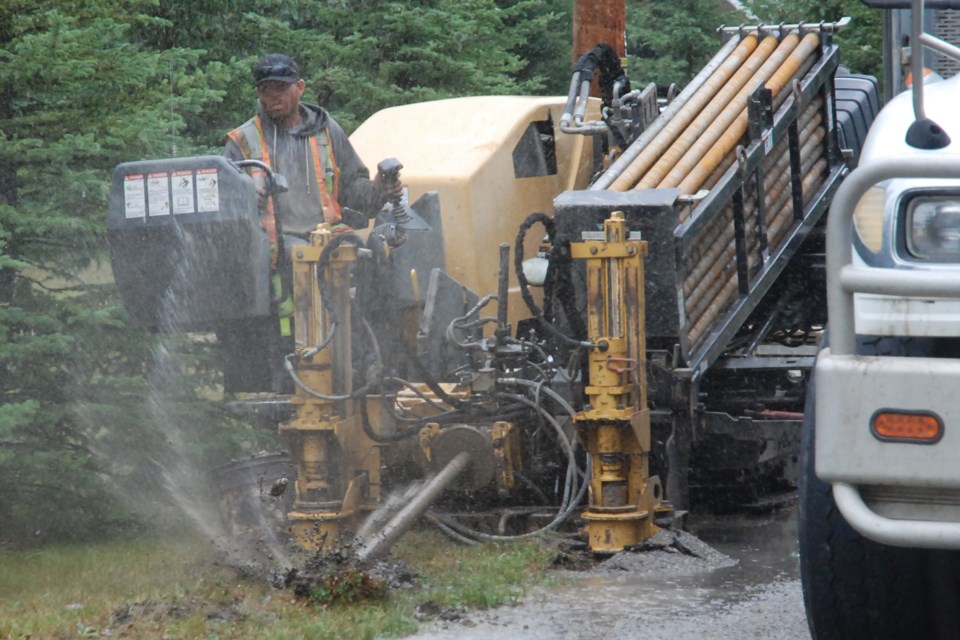SUNDRE — The new fibre optic broadband high speed internet infrastructure being deployed by Xplornet Communications Inc. is forecast by the company to go live in the second quarter of 2022.
Graham Fleet, Xplornet’s senior manager for government and public relations, told The Albertan on Tuesday, Oct. 12 during a phone interview that although there isn’t a specific completion date, the network is expected to be activated between March and June, at the latest.
Construction crews from Lethbridge-based contractor Cross Cut Directional Boring have for the past couple of months been busy trenching and drilling conduit lines.
“Each residence and business have a cable deployed right up to their premise, or with the option to connect later,” said Fleet.
“The network itself is going to be about 60 per cent aerial deployment and about 40 per cent underground,” he elaborated.
Permission forms to connect homes in areas where cables are going in the ground have been circulated, he said.
“Anybody can go on and express interest in getting a drop done to their house right now,” he said. “People (who opt in) will have the drop installed right to the side of their house.”
However, in locations where the fibre optic lines will be mounted aerially on Fortis power poles, connections to homes and businesses will commence once the company begins to officially market its service, he added.
“It will be a success-based install. So, the drop will be done at the time of install because there’s less ground disturbance — you can send out a small crew and don’t need to be drilling underneath,” he explained.
People who are located in an aerial deployment area are also encouraged to express their interest in signing up sooner rather than later, and they will eventually be notified once the service is being connected, he said.
Precisely what kinds of packages will be available and at what cost has not yet been determined, he said.
“The package is still being put together. If somebody was getting WiFi extenders on packages, then there may be certain add-ons. But as far as getting the actual service to the house, there will not be a cost,” he said.
That being said, Fleet was able to confirm that gigabit download speeds will be available.
“It’s not going to be fully synchronous service,” he said.
But significant upload speeds of roughly half the download speeds are anticipated, he said, adding businesses that require additional upload capacity could be accommodated with more customized service options.
Residents can expect rates and packages that will be of “little to no difference between what urban packages are,” he said.
Asked how much of the underground infrastructure had already been installed, Fleet said an update he’d seen a few weeks prior to being interviewed reported that more than 4,000 metres of trenching had been completed.
As for the remaining 60 per cent of the network that will be mounted aerially, he said an analysis of the poles is being completed.
“Each pole is basically almost treated like an individual tower,” he said. “That process is well underway and we know which poles may need to be replaced.”
But with winter looming around the corner, he said the top priority for the time being is to finish getting conduits buried before the ground freezes.
“The ground disturbance work is the focus right now,” he said, adding aerially mounted lines would come next.
As for the project’s approximate cost, Fleet could not immediately provide details, but could say the expense is in the vicinity to estimates previously determined by the municipality when a proposed publicly-owned network was being considered. That cost was in the ballpark of $3 million.
The leg work done by the town with regards to initial estimates, he said, seems to be very much in line with the project’s overall budget.
Meanwhile, although Xplornet recently spent about $250 million to acquire a significant portion of spectrum licences to drastically improve wireless speeds in areas where fibre does not make a solid business case, the communications company is not currently deploying broadband elsewhere in the province.
“We continue to add fibre to the network all the time, in terms of connecting towers to fibre. But there isn’t any specific other projects that are going on in Alberta right now that are Xplornet related.”



